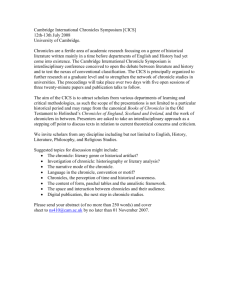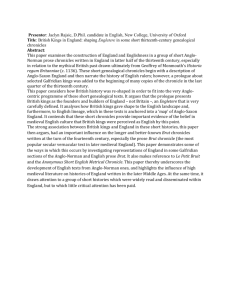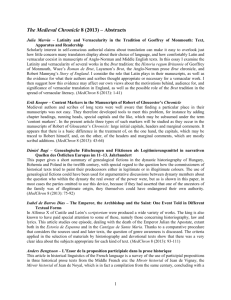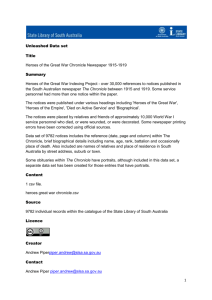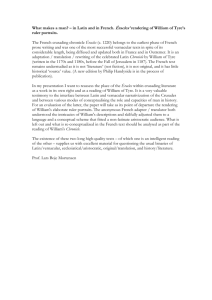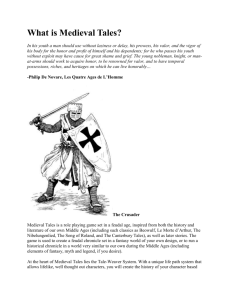The Medieval Chronicle V
advertisement
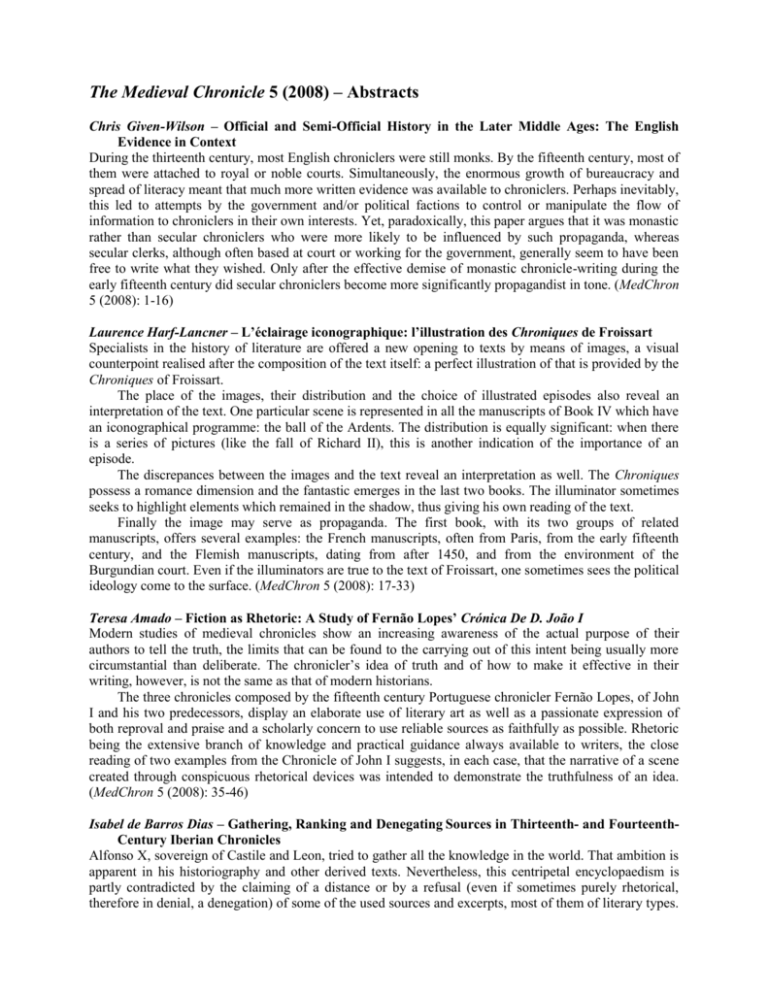
The Medieval Chronicle 5 (2008) – Abstracts Chris Given-Wilson – Official and Semi-Official History in the Later Middle Ages: The English Evidence in Context During the thirteenth century, most English chroniclers were still monks. By the fifteenth century, most of them were attached to royal or noble courts. Simultaneously, the enormous growth of bureaucracy and spread of literacy meant that much more written evidence was available to chroniclers. Perhaps inevitably, this led to attempts by the government and/or political factions to control or manipulate the flow of information to chroniclers in their own interests. Yet, paradoxically, this paper argues that it was monastic rather than secular chroniclers who were more likely to be influenced by such propaganda, whereas secular clerks, although often based at court or working for the government, generally seem to have been free to write what they wished. Only after the effective demise of monastic chronicle-writing during the early fifteenth century did secular chroniclers become more significantly propagandist in tone. (MedChron 5 (2008): 1-16) Laurence Harf-Lancner – L’éclairage iconographique: l’illustration des Chroniques de Froissart Specialists in the history of literature are offered a new opening to texts by means of images, a visual counterpoint realised after the composition of the text itself: a perfect illustration of that is provided by the Chroniques of Froissart. The place of the images, their distribution and the choice of illustrated episodes also reveal an interpretation of the text. One particular scene is represented in all the manuscripts of Book IV which have an iconographical programme: the ball of the Ardents. The distribution is equally significant: when there is a series of pictures (like the fall of Richard II), this is another indication of the importance of an episode. The discrepances between the images and the text reveal an interpretation as well. The Chroniques possess a romance dimension and the fantastic emerges in the last two books. The illuminator sometimes seeks to highlight elements which remained in the shadow, thus giving his own reading of the text. Finally the image may serve as propaganda. The first book, with its two groups of related manuscripts, offers several examples: the French manuscripts, often from Paris, from the early fifteenth century, and the Flemish manuscripts, dating from after 1450, and from the environment of the Burgundian court. Even if the illuminators are true to the text of Froissart, one sometimes sees the political ideology come to the surface. (MedChron 5 (2008): 17-33) Teresa Amado – Fiction as Rhetoric: A Study of Fernão Lopes’ Crónica De D. João I Modern studies of medieval chronicles show an increasing awareness of the actual purpose of their authors to tell the truth, the limits that can be found to the carrying out of this intent being usually more circumstantial than deliberate. The chronicler’s idea of truth and of how to make it effective in their writing, however, is not the same as that of modern historians. The three chronicles composed by the fifteenth century Portuguese chronicler Fernão Lopes, of John I and his two predecessors, display an elaborate use of literary art as well as a passionate expression of both reproval and praise and a scholarly concern to use reliable sources as faithfully as possible. Rhetoric being the extensive branch of knowledge and practical guidance always available to writers, the close reading of two examples from the Chronicle of John I suggests, in each case, that the narrative of a scene created through conspicuous rhetorical devices was intended to demonstrate the truthfulness of an idea. (MedChron 5 (2008): 35-46) Isabel de Barros Dias – Gathering, Ranking and Denegating Sources in Thirteenth- and FourteenthCentury Iberian Chronicles Alfonso X, sovereign of Castile and Leon, tried to gather all the knowledge in the world. That ambition is apparent in his historiography and other derived texts. Nevertheless, this centripetal encyclopaedism is partly contradicted by the claiming of a distance or by a refusal (even if sometimes purely rhetorical, therefore in denial, a denegation) of some of the used sources and excerpts, most of them of literary types. This attitude is all the more striking as this historiography not only absorbs excerpts of a more fictional tone, but also fully imitates literature to make its accounts more vivid and striking, and uses various rhetorical procedures. (MedChron 5 (2008): 47-60) Cristian Bratu – L’esthetique des chroniqueurs de la IVe Croisade et l’épistémè gothico-scolastique In his book Gothic Architecture and Scholasticism, Erwin Panofsky convincingly argued that medieval buildings and philosophical treatises emerged from a common episteme (or ‘mental habit’, to use his own words). My essay contends that Panofsky’s episteme has literary and historiographical ramifications as well. Although medieval historians such as Robert de Clari, Geoffroy de Villehardouin and Henri de Valenciennes may have had varying degrees of familiarity with contemporary architecture and philosophy, their chronicles belong nonetheless to the gothic-scholastic paradigm. Just like cathedrals and intellectual summae, thirteenth-century historiography is defined by the principles of linearity, repetition, progressive divisibility and synthesis. (MedChron 5 (2008): 61-76) Graeme Dunphy – On the Function of the Disputations in the Kaiserchronik The Kaiserchronik is generically puzzling. In essence it is a spiritual world chronicle, but it lacks the usual historiographical systematisations of its theological content. However it does have three disputations, an unusual feature in a chronicle which has to date not been adequately explained. This essay argues, on the basis of comparisons with works in other literary forms, that these passages function as key expressions of the controlling idea of the entire work, namely the progress of the Gospel from the heathen to the Christian Empire, and that they are strategically located within the chronicle at the turning points in the success of Christian mission. (MedChron 5 (2008): 77-86) Per Förnegård – Le Miroir historial de Jean de Noyal ou l’art de compiler Jean de Noyal’s Miroir historial is a world chronicle composed in Laon in Northern France in the 1380s of which only the three final books, X, XI and XII, have been preserved for posterity. Like other world chronicles, the Miroir is a compilation. In book X, the original passages are particularly few and quite brief – the original material in the chronicle is generally limited to explanatory sub-clauses. The remaining material is borrowed from other French or Latin works. The events are retold only partly in chronological order, and the Miroir sometimes gives two or three different versions of the same event. The fact that these repetitions are, without doubt, a deliberate method of compilation is proven by the references inserted by the Abbot in these instances. This method provides the reader with several interpretations of the same event. This article investigates the sources used in book X and describes its method of compilation. (MedChron 5 (2008): 87-98) Wojtek Jezierski – Taking Sides: Some Theoretical Remarks on the (Ab)Use of Historiography This article should be seen as an attempt to put the early medieval chronicles in a more theoretical frame concerning identity formation and creation of historical tradition. The empirical examples are provided by two tenth-century chronicles: Chronicon Æthelweardi by Æthelweard of Wessex, and Res gestae Saxonicae by Widukind of Corvey. As the theoretical frame serve the conclusions and ideas taken from the research on collective memory, discourse analysis, and a more general reasoning about the affinity between knowledge and power. In effect, the article illustrates not only those mechanisms and literary strategies, but also, more broadly, demonstrates the pointlessness of common accusations of medieval historiography’s failure in its pursuit of objectivity. Partiality was the raison d’être of medieval chronicles, and, it is argued, our research should focus more on its appearances. (MedChron 5 (2008): 99111) Linda Kaljundi – Waiting for the Barbarians: Reconstruction of Otherness in the Saxon Missionary and Crusading Chronicles, 11th –13th Centuries The article discusses the use of the rhetoric of Otherness during the expansion of Latin Christianity into the North from the ninth to the early thirteenth centuries. Arguing that the European encounters with the Other worlds have always been mediated by representations and images, it explores the transition from the classical image of the barbarian to the Christian understanding of pagan barbarians, and examines the role of textual authorities and intertextuality in the new discourse of Otherness. In addition, it discusses the role of that imagery in linking the local realm to the universal Christian history and geography, and in establishing the concept of identity and unity, the Christianitas at the Northern frontier. The study is based on four episcopal chronicles from the diocese of Hamburg-Bremen: Adam of Bremen’s Gesta Hammaburgensis Ecclesiae Pontificum (written around I075-76), Helmold of Bosau’s Chronica Slavorum (around 1167-68, 1172), Arnold of Lübeck’s Chronica Slavorum (around 1200/1211), and Henry of Livonia’s Chronicon Livoniae (around 1224-27). (MedChron 5 (2008): 113-27) Andy King and Julia Marvin – A Warning to the Incurious: M. R. James, the Scalacronica and the Anglo-Norman Prose Brut Chronicle Jesus College, Cambridge, MS Q.G.10 contains two chronicles of English history. One of them, an AngloNorman chronicle ending at 1272, was identified by M. R. James, the eminent Victorian scholar and writer of ghost stories, as a fragmentary text of Sir Thomas Gray’s Scalacronica. Although the chronicle indeed presents many verbal correspondences with Gray’s work, James was mistaken, and MS Q.G.10 in fact contains a version of the Anglo-Norman prose Brut chronicle; the similarities stem from Gray’s heavy use of the prose Brut in his narrative for the period 1100-1272. This paper discusses how James came to make his erroneous identification; assesses the relationship between the Brut text in MS Q.G.10 and other versions of the prose Brut; examines Thomas Gray’s adaption of the prose Brut, as well as his reticence about his use of it; and ends by considering some of the potential pitfalls of relying on manuscript catalogues. (MedChron 5 (2008): 129-45) Alison Williams Lewin – Chivalry and Romance in the Chronicle of Bindino da Travale Bindino da Travale (d. 1416), a minor artist living in Siena, decided late in life to compose a chronicle recounting major events in recent Sienese and Italian history. This cronaca, largely dictated, presents several striking features that separate it from both annals and newly emerging humanist histories. Bindino displays a wide range of knowledge: he can list more than 25 types of gemstone; he can name the nine orders of angels, in proper sequence; he even tries, with uneven results, to imitate the flowery and subtle speech of ambassadors. This essay focuses on one such unusual aspect of his chronicle, namely, its allusions to both form and content of chansons de geste. The resemblences argue for the persistence of this earlier literary form, at least in popular literature, and suggest literate non-elite Italians could use a rich non-humanist version of the past to interpret contemporary events. (MedChron 5 (2008): 147-59) Margarida Madureira – Le chroniqueur et son public: les versions latine et française de la Chronique de Guillaume de Tyr This paper analyses the various aspects through which author and translator represent in their texts different ideological conceptions about the Oriental Latin States. Addressing himself to a homogeneous community, with which he shares the feelings and the points of view, Guillaume de Tyr interprets the historical events from a subjective perspective, connecting them to the present. Unlike him, the French translator, as well as his reader, lacks identification with this territory as a geographic reality. They find, thus, on the concept of ‘Christendom’, a point of view that enables the reinterpretation of those historical events, integrating the history of crusades into their own Christian history. (MedChron 5 (2008): 161-74) Marigold Anne Norbye – ‘A tous nobles qui aiment beaux faits et bonnes histoires’: The Multiple Transformations of a Fifteenth-Century French Genealogical Chronicle A modest fifteenth-century French genealogical chronicle, A tous nobles qui aiment beaux faits, survives in about sixty-five copies, which are distinguished by their variations of content (over twenty different textual versions) and of appearance (manuscripts ranging from luxurious to crude, from roll to codex). This presupposes that numerous persons (‘remanieurs’) remodelled both content and format. These remanieurs might have been scribes who used their initiative or were asked by a patron to rewrite the work, or individuals who copied the book for their own use, amending their copy as they went. The remanieurs and their audiences belonged to circles where history was appreciated and unofficial historywriting took place: possibly government officials, more likely the lay aristocracy. In a period of increasing literacy and emerging national sentiment, the reshaping of historical narrative by the ‘remanieurs’ is witness to a lively culture in which history, politics and identity were closely linked. (MedChron 5 (2008): 175-96) Anti Selart – Iam tunc…. The Political Context of the First Part of the Chronicle of Henry of Livonia Discussed is the first part (events from ca.1180-ca.1205) of the Chronicle of Henry of Livonia (written ca. 1224-1227). The chronicle is, even if factually and chronologically mostly correct, an extremely apologetic work. Henry defends the Church of Riga here, toning down its internal conflicts and keeping silent about issues unbecoming to it. Describing the very beginning of the history of the Bishopric of Riga and the military order of the Brethren of the Sword, Henry presents almost only episodes, legitimising the Rigan crusades. According to the chronicle, Riga (and not the King of Denmark, or other counterparts of Riga) had not only all legal, moral and divine authorisations, but also the historical priority in Christianisation of Livonia. (MedChron 5 (2008): 197-209) Paul Trio – The Chronicle Attributed to ‘Olivier van Diksmuide’: a Misunderstood Town Chronicle of Ypres from Late Medieval Flanders The starting point of this research is the chronicle ascribed to Oliver of Dixmude, which deals with the period 1377-1443 and which has hitherto always been characterized as a regional ‘Flemish’ chronicle. However, the study of this often cited chronicle offers us new (after Ghent) evidence that during the fifteenth century the genre of the town chronicle was also rather successful in the Southern Low Countries, contrary to what has always been supposed. There are several reasons why the chronicle by Oliver of Dixmude has never before been given the epithet of urban chronicle. One of them is that the edition by Lambin from 1835 – the only edition of the manuscript, which was lost in 1914 – does not faithfully present the original text. Apart from omitting the annual lists of the members of the town government, Lambin also left out several of the ‘Ypres’ fragments. It is only thanks to a previously unstudied copy of the text found in the Courtrai Town Library, that these ‘lost’ passages could be retrieved. Besides, this chronicle should be studied in the context of a much broader fifteenth-century local tradition of recording important urban events in the form of a narrative account. Indeed, the hardly known chronicle ascribed to Pieter van de Letuwe, which discusses the immediately following period 1443-1480, is very similar in structure. Even if the authorship of the persons mentioned above can be maintained, it should be kept in mind that there existed a kind of collective authorship, the members of which belonged to the leading urban elite. (MedChron 5 (2008): 211-25)
